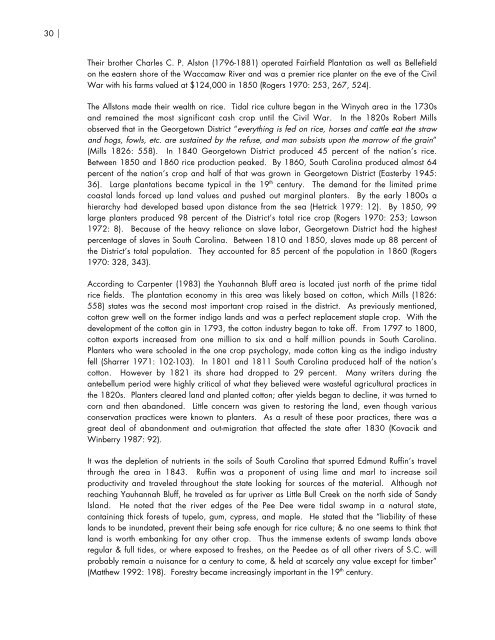Archaeological Investigations at Yourhaney Plantation (38GE18)
Archaeological Investigations at Yourhaney Plantation (38GE18)
Archaeological Investigations at Yourhaney Plantation (38GE18)
You also want an ePaper? Increase the reach of your titles
YUMPU automatically turns print PDFs into web optimized ePapers that Google loves.
30Their brother Charles C. P. Alston (1796-1881) oper<strong>at</strong>ed Fairfield Plant<strong>at</strong>ion as well as Bellefieldon the eastern shore of the Waccamaw River and was a premier rice planter on the eve of the CivilWar with his farms valued <strong>at</strong> $124,000 in 1850 (Rogers 1970: 253, 267, 524).The Allstons made their wealth on rice. Tidal rice culture began in the Winyah area in the 1730sand remained the most significant cash crop until the Civil War. In the 1820s Robert Millsobserved th<strong>at</strong> in the Georgetown District “everything is fed on rice, horses and c<strong>at</strong>tle e<strong>at</strong> the strawand hogs, fowls, etc. are sustained by the refuse, and man subsists upon the marrow of the grain”(Mills 1826: 558). In 1840 Georgetown District produced 45 percent of the n<strong>at</strong>ion’s rice.Between 1850 and 1860 rice production peaked. By 1860, South Carolina produced almost 64percent of the n<strong>at</strong>ion’s crop and half of th<strong>at</strong> was grown in Georgetown District (Easterby 1945:36). Large plant<strong>at</strong>ions became typical in the 19 th century. The demand for the limited primecoastal lands forced up land values and pushed out marginal planters. By the early 1800s ahierarchy had developed based upon distance from the sea (Hetrick 1979: 12). By 1850, 99large planters produced 98 percent of the District’s total rice crop (Rogers 1970: 253; Lawson1972: 8). Because of the heavy reliance on slave labor, Georgetown District had the highestpercentage of slaves in South Carolina. Between 1810 and 1850, slaves made up 88 percent ofthe District’s total popul<strong>at</strong>ion. They accounted for 85 percent of the popul<strong>at</strong>ion in 1860 (Rogers1970: 328, 343).According to Carpenter (1983) the Yauhannah Bluff area is loc<strong>at</strong>ed just north of the prime tidalrice fields. The plant<strong>at</strong>ion economy in this area was likely based on cotton, which Mills (1826:558) st<strong>at</strong>es was the second most important crop raised in the district. As previously mentioned,cotton grew well on the former indigo lands and was a perfect replacement staple crop. With thedevelopment of the cotton gin in 1793, the cotton industry began to take off. From 1797 to 1800,cotton exports increased from one million to six and a half million pounds in South Carolina.Planters who were schooled in the one crop psychology, made cotton king as the indigo industryfell (Sharrer 1971: 102-103). In 1801 and 1811 South Carolina produced half of the n<strong>at</strong>ion’scotton. However by 1821 its share had dropped to 29 percent. Many writers during theantebellum period were highly critical of wh<strong>at</strong> they believed were wasteful agricultural practices inthe 1820s. Planters cleared land and planted cotton; after yields began to decline, it was turned tocorn and then abandoned. Little concern was given to restoring the land, even though variousconserv<strong>at</strong>ion practices were known to planters. As a result of these poor practices, there was agre<strong>at</strong> deal of abandonment and out-migr<strong>at</strong>ion th<strong>at</strong> affected the st<strong>at</strong>e after 1830 (Kovacik andWinberry 1987: 92).It was the depletion of nutrients in the soils of South Carolina th<strong>at</strong> spurred Edmund Ruffin’s travelthrough the area in 1843. Ruffin was a proponent of using lime and marl to increase soilproductivity and traveled throughout the st<strong>at</strong>e looking for sources of the m<strong>at</strong>erial. Although notreaching Yauhannah Bluff, he traveled as far upriver as Little Bull Creek on the north side of SandyIsland. He noted th<strong>at</strong> the river edges of the Pee Dee were tidal swamp in a n<strong>at</strong>ural st<strong>at</strong>e,containing thick forests of tupelo, gum, cypress, and maple. He st<strong>at</strong>ed th<strong>at</strong> the “liability of theselands to be inund<strong>at</strong>ed, prevent their being safe enough for rice culture; & no one seems to think th<strong>at</strong>land is worth embanking for any other crop. Thus the immense extents of swamp lands aboveregular & full tides, or where exposed to freshes, on the Peedee as of all other rivers of S.C. willprobably remain a nuisance for a century to come, & held <strong>at</strong> scarcely any value except for timber”(M<strong>at</strong>thew 1992: 198). Forestry became increasingly important in the 19 th century.







